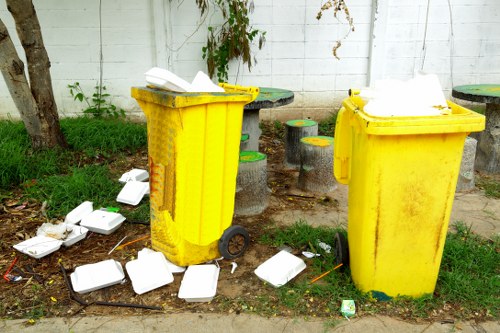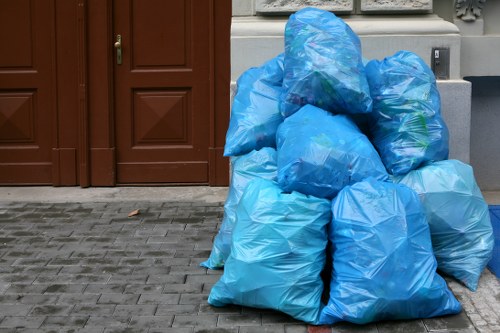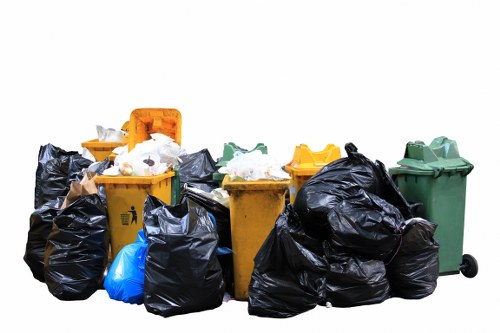Builders Waste Clearance in Rubbish Sucks

When it comes to **construction projects**, managing builders waste is a critical component that often gets overlooked. The accumulation of rubbish during and after a build can lead to significant problems if not handled properly.
Improper waste clearance not only affects the environment but can also pose safety hazards on construction sites. Therefore, understanding the importance of effective builders waste clearance is essential for ensuring a smooth and efficient construction process.
In this article, we'll delve into the challenges associated with builders waste, the impact it has on your project, and the best practices for efficient rubbish clearance.

Understanding Builders Waste
Builders waste refers to the materials leftover from construction, renovation, or demolition projects. This can include concrete, wood, metals, plastics, and other miscellaneous debris.
Proper management of this waste is crucial for several reasons:
- Environmental Protection: Minimizing waste reduces the strain on landfills and helps in conserving natural resources.
- Cost Efficiency: Efficient waste clearance can lower the overall cost of a construction project by reducing disposal fees and mitigating potential fines.
- Site Safety: A cluttered site increases the risk of accidents and injuries among workers.
By addressing builders waste proactively, construction companies can enhance their project outcomes and uphold their commitment to sustainability.

Common Challenges in Builders Waste Clearance
Clearing builders waste is not without its obstacles. Some of the common challenges include:
- Volume of Waste: Large construction projects generate substantial amounts of rubbish, making disposal a daunting task.
- Sorting and Segregation: Differentiating between recyclable materials and non-recyclable waste requires meticulous effort.
- Regulatory Compliance: Adhering to local waste management regulations can be complex and time-consuming.
Addressing these challenges effectively is key to maintaining an organized and compliant construction site.

Best Practices for Efficient Builders Waste Clearance
Implementing best practices in waste clearance can streamline the process and minimize negative impacts. Here are some strategies to consider:
1. Develop a Waste Management Plan
A comprehensive waste management plan outlines how waste will be handled throughout the project lifecycle. This includes identifying types of waste, methods of disposal, and responsible parties.
Key Components:
- Waste audit to determine quantities and types of materials.
- Strategies for reduction, reuse, and recycling.
- Roles and responsibilities of team members.
2. Segregate Waste at Source
Separating waste as it is generated simplifies the disposal process. Use clearly labeled containers for different types of materials such as wood, metal, and plastics.
Benefits:
- Facilitates recycling and reduces landfill usage.
- Improves site organization and safety.
- Helps in tracking waste quantities for accountability.
3. Partner with Professional Clearance Services
Engaging with experienced waste clearance services ensures that rubbish is removed efficiently and in compliance with regulations.
- Reliable and timely waste collection.
- Knowledge of local disposal laws.
- Access to recycling facilities and environmentally friendly disposal methods.

The Environmental Impact of Builders Waste
Builders waste, when not managed properly, can have severe environmental repercussions. These include:
- Pollution: Waste materials can contaminate soil and water sources, harming local ecosystems.
- Resource Depletion: Disposing of recyclable materials unnecessarily depletes natural resources and increases the demand for new raw materials.
- Greenhouse Gas Emissions: Decomposing waste in landfills contributes to the emission of harmful greenhouse gases like methane.
Adopting sustainable waste clearance practices mitigates these impacts and promotes environmental stewardship.

Cost Benefits of Effective Waste Clearance
Investing in proper builders waste clearance can lead to significant cost savings in the long run. Here's how:
- Reduced Disposal Fees: Efficient waste management minimizes the volume of waste, leading to lower disposal costs.
- Avoidance of Fines: Compliance with waste disposal regulations prevents costly penalties.
- Enhanced Project Efficiency: A well-maintained site reduces delays and improves worker productivity.
By focusing on effective waste clearance strategies, construction projects can achieve both financial and operational advantages.

Choosing the Right Waste Clearance Service
Selecting a reliable waste clearance service is pivotal for managing builders waste efficiently. Consider the following factors when making your choice:
1. Experience and Reputation
Opt for companies with a proven track record in handling construction waste. Positive reviews and testimonials are indicators of reliable service.
2. Range of Services
Ensure the service provider offers comprehensive solutions, including collection, transportation, sorting, and recycling of waste materials.
3. Compliance with Regulations
Choose a company that adheres to local and national waste management laws to ensure your project remains compliant.
4. Environmental Responsibility
Prioritize providers who emphasize sustainable practices, such as recycling and reducing landfill usage.

Implementing Recycling in Builders Waste Clearance
Integrating recycling into your waste clearance process not only benefits the environment but also enhances the sustainability of your construction projects.
Here are steps to incorporate recycling effectively:
- Identify Recyclable Materials: Common recyclable construction materials include metals, wood, concrete, and certain plastics.
- Set Up Segregation Systems: Use separate containers for different recyclable materials to streamline the sorting process.
- Partner with Recycling Facilities: Collaborate with local recycling centers to ensure materials are processed correctly.
- Educate Your Team: Train workers on the importance of recycling and proper waste segregation practices.
By prioritizing recycling, construction projects can significantly reduce their environmental footprint.

Technology in Builders Waste Clearance
Advancements in technology are transforming the way builders manage waste clearance. Innovative solutions offer increased efficiency and improved environmental compliance.
1. Waste Management Software
Software tools help in tracking waste generation, scheduling pickups, and monitoring disposal methods, ensuring a streamlined waste management process.
2. Automated Sorting Systems
Automated systems enhance the accuracy and speed of waste sorting, enabling better recycling rates and reducing manual labor.
3. Sustainable Disposal Technologies
Emerging technologies focus on eco-friendly disposal methods, such as waste-to-energy conversion, which minimizes landfill usage.

Legal Implications of Improper Waste Clearance
Failing to manage builders waste appropriately can lead to serious legal consequences. It's essential to understand the potential legal implications:
- Fines and Penalties: Non-compliance with waste disposal regulations can result in hefty fines and sanctions.
- Project Delays: Legal issues may cause significant delays in construction timelines, affecting overall project delivery.
- Reputation Damage: Legal troubles can tarnish a company's reputation, making it harder to secure future projects.
Ensuring proper waste clearance practices protects your business from these legal risks.

Health and Safety Considerations
Effective builders waste clearance is integral to maintaining a safe work environment. Neglecting waste management can lead to various health and safety issues:
- Injury Risks: Cluttered sites increase the likelihood of trips, falls, and other accidents.
- Exposure to Hazardous Materials: Improperly handled waste may contain harmful substances that can pose health risks to workers.
- Fire Hazards: Accumulated waste, especially combustible materials, can elevate the risk of fires on site.
Adhering to strict waste clearance protocols safeguards the well-being of all personnel involved in the construction process.

Sustainable Waste Clearance Practices
Embracing sustainability in builders waste clearance not only benefits the environment but also enhances the overall quality of construction projects.
1. Reduce Waste Generation
Implementing design strategies that minimize material waste can significantly decrease the amount of rubbish needing clearance.
2. Reuse Materials
Identifying opportunities to reuse construction materials reduces the demand for new resources and minimizes landfill contributions.
3. Optimize Transportation
Efficient waste transport logistics lower carbon emissions and reduce overall environmental impact.

Case Studies: Successful Waste Clearance Strategies
Examining real-world examples can provide valuable insights into effective waste clearance practices.
Case Study 1: GreenBuild Construction
GreenBuild implemented a comprehensive waste management plan that included waste segregation, recycling partnerships, and regular site clean-ups. As a result, they reduced their waste disposal costs by 30% and minimized their environmental footprint.
Case Study 2: EcoRenovate Solutions
EcoRenovate focused on reusing materials wherever possible, leading to significant savings on material costs and reducing the volume of waste sent to landfills. Their sustainable approach also enhanced their reputation among eco-conscious clients.

Future Trends in Builders Waste Clearance
The field of waste clearance is continually evolving, with emerging trends poised to shape future practices:
- Circular Economy: Emphasizing the reuse and recycling of materials to create a closed-loop system.
- Smart Waste Solutions: Utilizing IoT and AI technologies for more efficient waste tracking and management.
- Zero Waste Construction: Striving for projects that generate no waste through meticulous planning and innovative techniques.
Staying abreast of these trends enables construction companies to adopt forward-thinking waste clearance strategies.

Conclusion
Builders waste clearance is a critical aspect of construction projects that cannot be ignored. Effective waste management ensures environmental protection, cost efficiency, and site safety, all of which contribute to the success of any building endeavor.
By implementing best practices, partnering with reliable clearance services, and embracing sustainable methods, construction companies can navigate the challenges of waste clearance seamlessly.
Don't let rubbish hold your project back. Contact us today to learn more about our comprehensive builders waste clearance services and ensure your construction site remains clean, safe, and efficient.